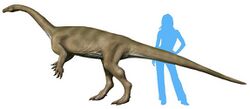Biology:Macrocollum
| Macrocollum | |
|---|---|

| |
| Restoration | |
| Scientific classification | |
| Domain: | Eukaryota |
| Kingdom: | Animalia |
| Phylum: | Chordata |
| Clade: | Dinosauria |
| Clade: | Saurischia |
| Clade: | †Sauropodomorpha |
| Clade: | †Unaysauridae |
| Genus: | †Macrocollum Müller et al., 2018 |
| Species: | †M. itaquii
|
| Binomial name | |
| †Macrocollum itaquii Müller et al., 2018
| |
Macrocollum is a genus of unaysaurid sauropodomorph dinosaur that lived during the Late Triassic period (early Norian) in what is now Brazil . It is one of the oldest dinosaurs known.[1]
Discovery
Macrocollum was discovered in 2012 in Rio Grande do Sul, Brazil, at the Wachholz site of the Candelária Formation, Paraná Basin.[2] It was announced in a press conference on November 21, 2018. The generic name combines the Greek word μακρός (long) and the Latin word collum (neck), referring to the animal's elongated neck. The specific epithet honours José Jerundino Machado Itaqui, one of the main persons behind the creation of CAPPA/UFSM.[1]
Description
Like most early dinosaurs, Macrocollum was relatively small, and walked on two legs. It was only 3.5 meters (11 feet) long, 1.5 meters (4.9 ft) tall, and weighed about 101.6 kilograms (224 lb).[original research?][1]
The known remains of Macrocollum are relatively well preserved. The holotype specimen consists of an almost complete and articulated skeleton. The two paratype specimens are both articulated skeletons with one missing a skull and its cervical series.[1]
Macrocollum itaquii differs from all other known sauropodomorphs based on a unique combination of characters such as those found on the skull, which include an antorbital fossa perforated by a promaxillary fenestra, and a medial margin of the supratemporal fossa with a simple smooth curve at the frontal/parietal suture.[1]
Classification
Macrocollum, alongside Jaklapallisaurus and Unaysaurus, was found to belong to the clade Unaysauridae.[1]
Paleoecology
Macrocollum lived between about 225.42 to 225 million years ago, in the Norian age of the late Triassic period. It was found in the south of Brazil, which at the time was connected to northwest Africa. At the time, most of the Earth's landmass was united into the supercontinent Pangaea, which was just starting to divide into Laurasia in the north, and Gondwana in the south.[3][4] U-Pb (Uranium decay) dating found that the Caturrita Formation, close to the holotype locality, dates to around 225.42 million years ago, making it fewer than 10 million years younger than the Santa Maria and Ischigualasto Formations, from where the earliest dinosaurs are known.[5]
Studies
The ilia of one of the paratypes of Macrocollum (CAPPA/UFSM 0001b) were used as a model in a study on the taphonomical effects of sedimentary compression on the iliac morphology of early sauropodomorphs.[6]
References
- ↑ 1.0 1.1 1.2 1.3 1.4 1.5 Rodrigo Temp Müller; Max Cardoso Langer; Sérgio Dias-da-Silva (2018). "An exceptionally preserved association of complete dinosaur skeletons reveals the oldest long-necked sauropodomorphs". Biology Letters 14 (11): 20180633. doi:10.1098/rsbl.2018.0633. PMID 30463923.
- ↑ Müller, Rodrigo Temp; da Rosa, Átila Augusto Stock; Roberto da Silva, Lúcio; Aires, Alex Sandro Schiller; Pacheco, Cristian Pereira; Pavanatto, Ane Elise Branco; Dias-da-Silva, Sérgio (August 2015). "Wachholz, a new exquisite dinosaur-bearing fossiliferous site from the Upper Triassic of southern Brazil". Journal of South American Earth Sciences 61: 120–128. doi:10.1016/j.jsames.2014.10.009. Bibcode: 2015JSAES..61..120M.
- ↑ Leal, L.A.; Azevodo, S.A.K.; Kellner, A.A.W.; da Rosa, A.A.S. (2004). "A new early dinosaur (Sauropodomorpha) from the Caturrita Formation (Late Triassic), Paraná Basin, Brazil". Zootaxa 690: 1–24. doi:10.11646/zootaxa.690.1.1. http://www.mapress.com/zootaxa/2004f/z00690f.pdf.
- ↑ Soares, M.B.; Schultz, C.L.; Horn, B.L.D. (2011). "New information on Riograndia guaibensis Bonaparte, Ferigolo & Ribeiro, 2001 (Eucynodontia, Tritheledontidae) from the Late Triassic of southern Brazil: anatomical and biostratigraphic implications". Anais da Academia Brasileira de Ciências 83 (1): 329–354. doi:10.1590/S0001-37652011000100021. ISSN 0001-3765.
- ↑ Langer, M.C.; Ramezani, J.; Da Rosa, Á.A.S. (2018). "U-Pb age constraints on dinosaur rise from south Brazil". Gondwana Research X (18): 133–140. doi:10.1016/j.gr.2018.01.005. Bibcode: 2018GondR..57..133L.
- ↑ Müller, Rodrigo Temp; Garcia, Maurício Silva; Da-Rosa, Átila Augusto Stock; Dias-da-Silva, Sérgio (December 2018). "Under pressure: Effect of sedimentary compression on the iliac morphology of early sauropodomorphs". Journal of South American Earth Sciences 88: 345–351. doi:10.1016/j.jsames.2018.09.005. Bibcode: 2018JSAES..88..345M.
Wikidata ☰ Q58979887 entry


